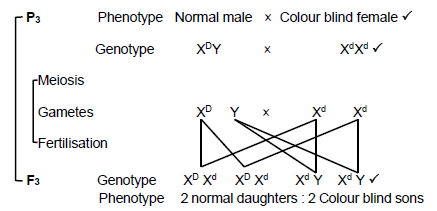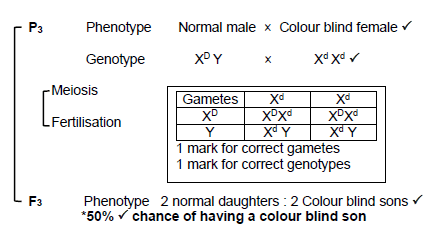LIFE SCIENCES GRADE 12 MEMORANDUM - PAST PAPERS 2017 JUNE
Share via Whatsapp Join our WhatsApp Group Join our Telegram GroupLIFE SCIENCES
GRADE 12
NATIONAL SENIOR CERTIFICATE
MEMORANDUM
JUNE 2017
SECTION A
QUESTION 1
1.1
1.1.1 A ✓✓
1.1.2 A ✓✓
1.1.3 B ✓✓
1.1.4 C ✓✓
1.1.5 C ✓✓
1.1.6 D ✓✓
1.1.7 B ✓✓
1.1.8 A ✓✓
1.1.9 B ✓✓
1.1.10 D ✓✓ (10 x 2) (20)
1.2
1.2.1 Axon \✓
1.2.2 Multiple sclerosis ✓
1.2.3 Parasympathetic ✓
1.2.4 Co-dominance ✓
1.2.5 Continuous variation ✓
1.2.6 Metaphase 2 ✓
1.2.7 Umbilical vein ✓
1.2.8 Non-disjunction ✓
1.2.9 Ribosome ✓
1.2.10 Anticodon ✓ (10 x 1) (10)
1.3
1.3.1 B only ✓✓
1.3.2 A only ✓✓
1.3.3 A only ✓✓ (3 x 2) (6)
1.4
1.4.1
- Nucleus ✓ and Mitochondria (2)
- (DNA) replication ✓ (1)
- Interphase ✓ (1)
- Nucleotides ✓ (1)
- 1 – Thymine ✓ 2 – Guanine ✓ 3 – (Weak) hydrogen bond ✓ (3)
1.5
1.5.1
- 8/16 = ½ = 50% ✓
- 4/16 = ¼ = 25% ✓(1)
1.5.2
- Ry ✓ (1)
- Ry, ry ✓ (1)
1.5.3 (e) Round and green ✓ (1)
1.5.4 8 Round yellow : 8 Round green = 1 : 1 ✓ (1)
TOTAL SECTION A: 50
SECTION B
QUESTION 2
2.1
2.1.1
A – Nuclear membrane ✓ (1)
C – Nucleoplasm ✓ (1)
D – Cytoplasm ✓ (1)
2.1.2
- Prophase 1 ✓ (1)
- Metaphase 1 ✓ (1)
2.1.3 Homologous chromosomes ✓/ Bivalent (1)
2.1.4 Crossing over ✓(1)
2.1.5
| Marking guideline | |
| Any 1 label | 1 mark |
| Both chromosomes the same size | 1 mark |
| Correct shading | 1 mark |
(3)
2.2
2.2.1
- 21 ✓ (1)
- 6 ✓ (1)
- 7 ✓ (1)
2.2.2 8 – GUG ✓ (1)
9 – CUG ✓ (1)
10 – ACU ✓ (1)
11 – CCU ✓ (1)
2.2.3
- Valine ✓ (1)
- Histidine ✓ (1)
- Leucine ✓ (1)
2.2.4
- Gene mutation ✓ (1)
- Glutamate ✓ (1)
2.2.5
- Since the sequence of nitrogenous bases in a gene ✓
- determines the sequence of amino acids ✓ in a protein molecule
- a mutation can change the amino acid sequence of the resulting protein. ✓
- Formation of a different protein ✓ leads to
- abnormal metabolism or cessation of metabolic activity ✓/ not functional. (Any 3 x 1) (3)
(15)
2.3
2.3.1 An increase / decrease in light intensity will cause, the diameter of the pupil to decrease / increase. ✓✓
OR
The diameter of the pupil will increase / decrease as the light intensity increases / decreases.
OR
An increase in light intensity will have no effect on the diameter of the pupil. ✓✓ (2)
2.3.2
- The diameter of pupil ✓ (1)
-
- The distance between the source of light and the position of the eye. ✓
- Same eye used at various light intensities. ✓
- Surrounding light must be kept at 0 lux ✓/dark. (Any 1 x 1) (1)
2.3.3 The diameter of pupil measured at 0 lux was used as a control ✓ to compare ✓ any change in diameter at various light intensities. (2)
2.3.4 7 – 2 = 5
5 ×100 ✓ =71,4% ✓ (2)
7
2.3.5 Under high light intensity:
- The circular muscles of the iris contract ✓
- The radial muscle relax ✓
- The pupil constricts ✓
- The amount of light entering the eye is reduced. ✓ (4)
2.3.6 When the retina is exposed to high intensity light, the photoreceptor cells ✓ (rods and cones) will be damaged or destroyed ✓ causing blindness. ✓ (3)
[40]
QUESTION 3
3.1
3.1.1
- Normal female (1)
- XDXd ✓ (1)
3.1.2
- Colour blindness is caused by a recessive allele ✓
- Carried on the X chromosomes ✓
- Females have two X chromosomes ✓ / Male only have one X chromosome
- Females must inherit two copies of the recessive allele ✓/ females who inherit only one of the recessive allele are still normal.
(Any 3 x 1) (3)
3.1.3
*50% chance of having a colour blind son
P3 and F3 (P1 and F1) ✓
Meiosis and fertilisation✓
(*1 Compulsory + Any 6) (7)
OR
P3 and F3 (P1 and F1) ✓
Meiosis and fertilisation✓
(*1 compulsory + Any 6) (7)
3.2
3.2.1 The shedding of the endometrium lining ✓ of the uterus accompanied by bleeding, ✓ occurs once in about 28 days. (2)
3.2.2 On the 14th ✓ day of the menstrual cycle. (1)
3.2.3
- The endometrium lining becomes thinner ✓/ decreases as it breaks down and detach from the uterus. (1)
- The endometrium wall gradually becomes thicker, ✓ more vascular and glandular. (1)
3.2.4
- The pituitary gland begins to secrete hormone oestrogen ✓ from the day 7 causing endometrium wall to become thicker, more vascular glandular. ✓
- The Luteinizing hormone ✓ secreted by the pituitary gland, causes ovulation ✓ / and converts the empty Graafian follicle into a structure called corpus luteum.
- The corpus luteum secretes a hormone known progesterone which causes further thickening of endometrium ✓ lining to prepare it for possible implantation of an embryo. (6)
3.2.5
- The higher levels of progesterone ✓ inhibit the secretion of FSH ✓ by the pituitary gland
- so that no further development of Graafian follicles ✓ to release mature ovum (ovulation) ✓ that may lead to possible fertilisation. (4)
3.3
3.3.1 An organism’s complete set of genes. (1)
3.3.2 The cloning involves the transfer of a nucleus from the cell of an animal with a desirable trait into the ovum of another animal where the nucleus have been removed.✓ (2)
3.3.3
- To assess the risks to human health ✓ / environment
- To determine if the presence of the transferred gene will affect the expression of other genes ✓
- To test the effectiveness of the product ✓ (Any 1 x 1) (1)
3.3.4
- Produce crops that are resistant to adverse conditions ✓/ drought/ disease / pests.
- Increase crop yield. ✓
- Change the time for the ripening of fruits. ✓
- Increase shelf life of plant products. ✓
- Improve nutritional value of food. ✓
- Improve the taste of food. ✓
- Developing fruit/ plants with desirable characteristics. ✓ (Any 3 x 1) (3)
3.4
- The mitochondria contain (mitochondrial) DNA ✓
- At fertilisation, only the nucleus of the sperm cell enters the egg ✓
- to fuse with the nucleus of the egg cell. ✓
- Therefore, the zygote still contains the mitochondria and hence the mitochondrial DNA of the egg cell from the mother ✓
- This DNA is passed from mother to child. ✓
- Mutations in mitochondrial DNA enable us to trace our female line of descent. ✓ (6)
[40]
SECTION C
QUESTION 4
*Accommodation of the eye ✓
- The ciliary muscle relax ✓
- Suspensory ligaments become taut ✓
- Tension on the lens increases ✓
- The lens becomes flattened (less convex) ✓
- The refractive power of the lens is decreased ✓
- A clear image of the distant object which is the traffic robot is now focused on the retina ✓ (*1 compulsory mark + Any 4) (5)
Hearing
- Pinna traps / directs the sound waves ✓
- Into the ear canal ✓/ meatus
- This causes the tympanic membrane to vibrate
- The vibration is transmitted to the auditory ossicles ✓/ name all 3
- The ossicles amplify the vibration ✓
- And transmit it to the oval window ✓
- The oval window vibrates ✓
- Creating waves ✓
- In the fluid / endolymph of the cochlea ✓
- Which stimulates the Organ of corti ✓
- To convert the wave into an impulse ✓
- The impulse travels along the auditory nerve ✓
- to the cerebrum ✓
- where it is interpreted as the siren of an ambulance. (Max. 7) (7)
Restoring balance
- The maculae ✓
- In the utriculus and sacculus ✓ and
- The cristae ✓
- In the semi-circular canals ✓ are stimulated
- They generate impulses ✓
- Which is transmitted through the auditory nerve ✓
- To the cerebellum ✓ where they are interpreted
- Impulses are transmitted via the motor neuron ✓
- to skeletal muscles ✓ (Max. 5)
Content:(17)
Synthesis:(3)
(20)
ASSESSING THE PRESENTATION OF THE ESSAY
| Relevance | Logical sequence | Comprehensive |
| All information provided is relevant to the question. | Ideas arranged in a logical sequence. | Answered all aspects required by the essay. |
| All information provided is relevant to accommodation of the eye, hearing and restoring body balance. | All information regarding accommodation of the eye, hearing and restoring body balance is arranged in a logical manner. | At least the following marks should be obtained: Accommodation of the eye (3/5) Hearing (5/7) Restoring balance(3/5) |
| 1 Mark | 1 Mark | 1 Mark |
TOTAL SECTION C: 20
GRAND TOTAL: 150